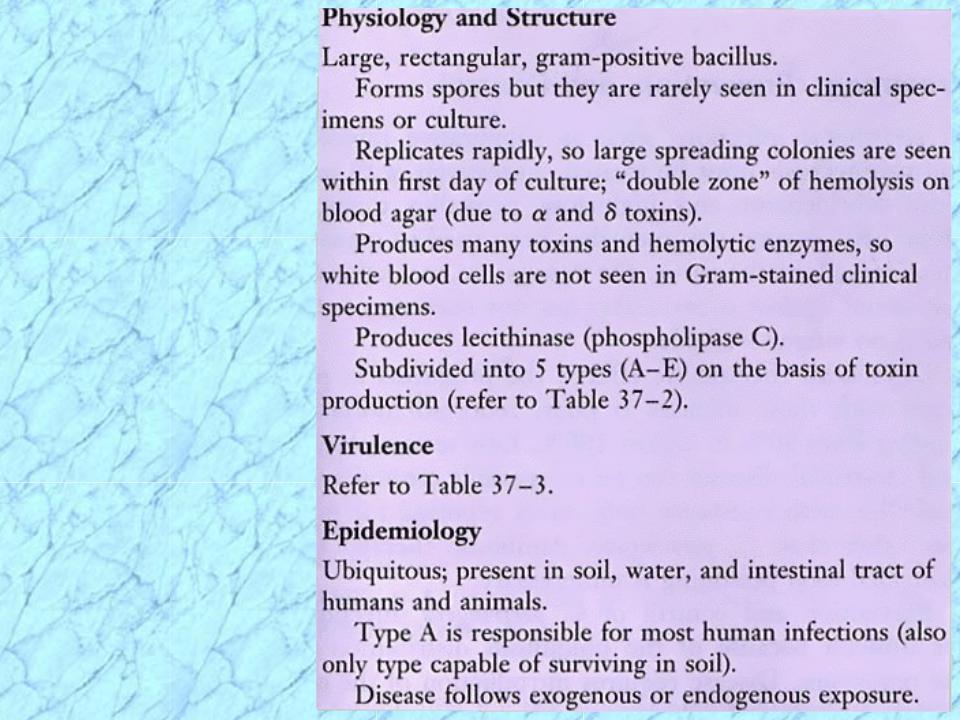
- •Clostridium
- •See Lecture Handouts
- •Clostridium spp. Anaerobic Gram-Positive Spore-Forming Bacilli
- •Spores
- •Clostridium Associated Human Disease
- •Clostridium perfringens
- •Clostridium perfringens — histotoxic or enterotoxigenic infections
- •Summary of C. perfringens Infections
- •Micro & Macroscopic C. perfringens
- •Summary of C. perfringens Infections (cont.)
- •Clostridial Cellulitis
- •C. perfringens Virulence Factors
- •Exotoxins Associated with C. perfringens Types A-E
- •C. perfringens Nagler Reaction
- •Clostridium tetani
- •Clostridium tetani — agent of tetanus
- •Summary of C. tetani Infections
- •Summary of Clostridium tetani Infections (cont.)
- •Clostridium tetani Gram Stain
- •Clinical Forms of Tetanus
- •Opisthotonos in Tetanus Patient
- •Risus Sardonicus in Tetanus Patient
- •Mechanism of Action
- •Clostridium botulinum
- •Summary of C. botulinum Infections
- •Summary of C. botulinum Infections
- •C. botulinum — agent of botulism, a rare, but severe (lethal) neuroparalytic disease
- •Mechanism of Action
- •Rates of
- •Clostridium dificile
- •Summary of
- •Summary of
- •Antibiotic-
- •Antibiotic-Associated Colitis
- •C. dificile Virulence Factors
- •Other Clostridium
- •Virulence
- •REVIEW
- •Clostridium spp. Anaerobic Gram-Positive Spore-Forming Bacilli
- •See Lecture Handouts
- •Spores
- •Review of Clostridium perfringens
- •Clostridium perfringens — histotoxic or enterotoxigenic infections
- •Micro & Macroscopic C. perfringens
- •C. perfringens Virulence Factors
- •Exotoxins Associated with C. perfringens Types A-E
- •C. perfringens Nagler Reaction
- •Review of Clostridium tetani
- •Clostridium tetani — agent of tetanus
- •Clostridium tetani Gram Stain
- •Clinical Forms of Tetanus
- •Mechanism of Action
- •Review of Clostridium botulinum
- •C. botulinum — agent of botulism, a rare, but severe (lethal) neuroparalytic disease
- •Mechanism of Action
- •Review of Clostridium dificile
- •Summary of
- •Summary of


Clostridium

See Lecture Handouts

Clostridium spp. Anaerobic Gram-Positive Spore-Forming Bacilli
Four broad types of pathogenesis:
1. Histotoxic group — tissue infections
(C. perfringens type A, exogenously acquired more commonly than endogenously) (C. septicum; endogenously-acquired)
a.cellulilitis
b.myonecrosis
c.gas gangrene
d.fasciitis
2.Enterotoxigenic group — gastrointestinal disease
a.clostridial foodbome disease (8-24h after ingestion of large numbers of organisms on con-taminated meat products, spores germinate, enterotoxin produced (C. perfringens type A)
b.necrotizing enteritis (beta toxin-producing C.perfringens type C)
(C. difficile endogenously-acquired or exogenously-acquired person-to-person in hospital)
c.antibiotic-associated diarrhea
d.antibiotic-associated pseudomembrane colitis
3.Tetanus (exogenously acquired) — C. tetani neurotoxin
a.generalized (most common)
b.cephalic(primary infection in head, comnnonly ear)
c.localized
e.neonatal (contaminated umbilical stump)
4.Botulism (exogenously acquired) — C. botulinum neurotoxin
a.foodborne (intoxication,1-2days incubation period)
b.infant (ingestion of spores in honey)
c.wound (symptoms similar to foodborne, but 4 or more days incubation)

Spores
Clostridium form endospores under adverse environmental conditions
Spores are a survival mechanism
Spores are characterized on the basis of position, size and shape
Most Clostridium spp., including C. perfringens and C. botulinum, have ovoid subterminal (OST) spores
C. tetani have round terminal (RT) spores

Clostridium Associated Human Disease

Clostridium perfringens

Clostridium perfringens — histotoxic or enterotoxigenic infections
Morphology and Physiology
•large, rectangular bacilli (rod) staining gram-positive
•spores rarely seen in vitro or in clinical specimens (ovoid, subterminal)
•non-motile, but rapid spreading growth on blood agar mimics growth of motile organisms
•aerotolerant, especially on media supplemented with blood
•grow at temperature of 20-50°C (optimum 45°C) and pH of 5.5-8.0
Pathogenicity Determinants (note that toxins include both cytolytic enzymes and bipartite exotoxins)
•four major lethal toxins (alpha ( ), beta ( ), epsilon ( ), and iota ( ) toxins) and an enterotoxin
•six minor toxins (delta( ), theta( ), kappa( ), lambda( ), mu( ), nu( )toxins) & neuraminadase
•C. perfringens subdivided into five types (A-E) on basis of production of major lethal toxins
•C. perfringens Type A (only major lethal toxin is alpha toxin) responsible for histotoxic and
enterotoxigenic infections in humans; Type C causes necrotizing enteritis (not in U.S.)
Lab Identification
•direct smear and Gram stain, capsules upon direct examination of wound smears
•culture takes advantage of rapid growth in chopped meat media at 45° C to enrich and then
isolate onto blood agar streak plate after four to six hours
•gas from glucose fermentation
•in vivo toxicity testing and identification of the specific toxin types involved
•double zone of hemolysis on blood agar (p-hemolytic theta(e) toxin, a-hemolytic alpha(oc) toxin)
•Nagler rxn; precipitation in serum or egg yolk media; oc -toxin (phospholipase C) is a lecithinase
•"stormy" fermentation (coagulaltion) of milk due to large amounts of acid and gas from lactose
Diagnosis/Treatment of systemic infection — Early diagnosis and aggressive treatment essential
•removal of necrotic tissue (surgical debridement)
•Penicillin G in high doses if more serious infection
Of poorly defined clinical value are:
•administration of antitoxin
•hyperbaric oxygen (dive chamber) adjunct therapy (??inhibit growth of anaerobe??)

Summary of C. perfringens Infections

Micro & Macroscopic C. perfringens
NOTE: Large rectangular |
NOTE: Double zone of hemolysis |
gram-positive bacilli |
|
Inner beta-hemolysis = θ toxin Outer alpha-hemolysis = α toxin

